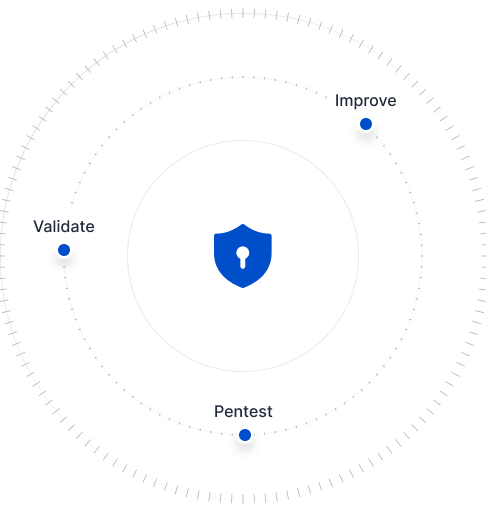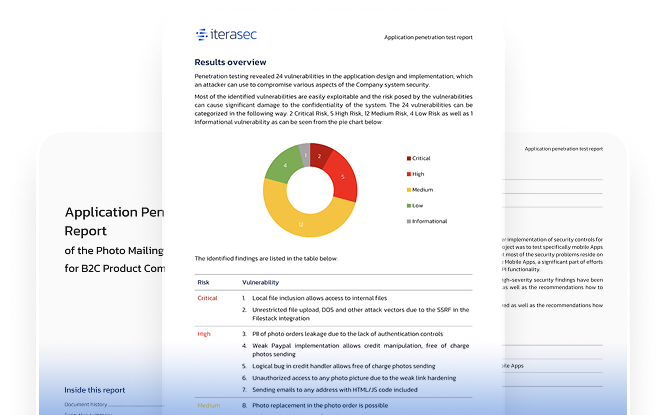Our penetration testing services offer a holistic approach
Manual testing
At Iterasec, a leading pentesting company, our manual testing approach is designed to simulate real-world attackers, not just machines. Hence, effective pen testing is manual only to go beyond what scanners can find and simulate real adversaries.
Remediation
As part of our comprehensive cyber security penetration testing services, we provide support to fix the identified vulnerabilities properly. Free re-test included within three months after report delivery.
Solid report
Get a professional pentest report as part of our pentest services with detailed finding descriptions and analysis of the work performed. On top of that, we provide an attestation letter you can show to your clients.
Not just pentesting
Pentesting is just the first step. We holistically help you build an efficient application security program and protect your infrastructure.
Types of Penetration Testing Services We Provide
Web application pentest
Our web application penetration testing evaluates security by discovering vulnerabilities and simulating sophisticated cyberattacks. We follow and extend beyond the OWASP Application Security Verification Standard (ASVS), not limiting ourselves to mere checklists.
Our focus is on discovering and understanding the impact of significant vulnerabilities like injections, XSS, DoS, backend and complex business logic issues, and many more.
We aim to identify innovative vulnerability chains that might be missed by automated tools, ensuring a thorough and comprehensive assessment. This approach helps in unearthing deep-seated vulnerabilities that could be exploited by real-world attackers, providing a robust defense against advanced cyber threats.
Mobile application pentest
This service delves deep into the security of mobile applications on platforms such as iOS and Android. We concentrate on critical aspects, like how mobile applications may expose backend systems to risks.
Our testing encompasses an examination of data security at rest and in transit, encryption mechanisms, and evaluating authentication processes. Additionally, we pay special attention to binary protection, assessing the resilience of mobile apps against reverse engineering and tampering.
While mainly based on OWASP Mobile Application Security Verification Standard (ASVS), we do not limit ourselves to mere checklists.
API penetration testing
In today’s interconnected digital landscape, APIs are ubiquitous and often a focal point for data leakage and authorization/authentication errors. Our API penetration testing comprehensively evaluates various API types including REST, GraphQL, SOAP, etc.
We focus on identifying insecure endpoints and probing for unauthorized access vulnerabilities. This thorough examination also includes checks for data exposure risks, ensuring that sensitive information is adequately protected.
By simulating realistic attack scenarios on these interfaces, our service aims to fortify the API against a wide range of cyber threats.
Internal network pentest
This service focuses on identifying vulnerabilities within an organization’s internal network. We simulate insider threats to uncover weaknesses like unprotected assets, unpatched systems, and internal access control issues.
The goal is to detect and mitigate threats that could be exploited by someone with internal network access, such as employees or contractors.
External network pentest
Our external network pentest aims to evaluate the security of an organization’s external-facing network infrastructure. We simulate attacks that external hackers might use to exploit network vulnerabilities, focusing on areas like exposed services, firewall configurations, and perimeter defense mechanisms.
This testing helps in identifying weaknesses that could be exploited from outside the network, such as through the Internet. The objective is to fortify the external network defenses, preventing unauthorized access and securing the network against external cyber threats.
Cloud security testing
Our cloud security testing goes beyond traditional vulnerability assessments to include simulated external attacks on cloud infrastructures like AWS, Azure, and GCP.
We thoroughly examine potential misconfigurations, inadequate access controls, and compliance issues. Our team scrutinizes every aspect of cloud infrastructure, from storage and applications to services, ensuring that they adhere to the highest security standards.
We also focus on identifying unique vulnerabilities that may arise in different cloud environments, ensuring that your cloud assets are not only compliant but also resilient against sophisticated cyber threats.
Container security testing
This testing targets the security of containerized applications, focusing on crucial aspects such as container orchestration, image vulnerabilities, and runtime configurations.
Our experts analyze cluster setups, evaluate security hygiene, and explore known attacks to understand the impact of a microservice compromise. Special attention is given to popular container systems like Kubernetes and OpenShift.
We aim to uncover vulnerabilities that could compromise the integrity and confidentiality of containerized applications, ensuring that your container environments are robust against both common and advanced security threats.
Embedded pentest
Our embedded system penetration tests are designed to identify and mitigate vulnerabilities in embedded systems and devices. This includes in-depth analysis of firmware for potential exploitation, such as buffer overflow vulnerabilities.
We also examine UEFI, bootloaders, BIOS, and BMC, assessing them for security weaknesses. By understanding and exploiting these vulnerabilities, we aim to strengthen the security of your embedded systems, ensuring they are resilient against targeted cyberattacks and hardware exploitation techniques.
IoT pentest
We specialize in testing IoT devices and ecosystems, focusing on areas such as insecure communication, weak authentication, and software flaws.
Among different tests, we particularly look at the security of over-the-air (OTA) update mechanisms, ensuring they are properly signed and validated. We also assess common network attacks, providing a comprehensive security review of IoT devices and their interconnected environment.
This thorough approach ensures that your IoT devices are safeguarded against a variety of potential security breaches.
Attack surface analysis
Our attack surface analysis service provides a comprehensive assessment of all potential attack vectors against your systems. This includes identifying exposed and vulnerable areas that external attackers might exploit.
We help you understand the riskiest attack vectors and advise on protective measures. Conducting this exercise continuously is recommended to stay ahead of evolving threats and to maintain a strong security posture.
Compliance driven pentests
Tailored to meet specific regulatory and compliance standards such as ISO 27001, SOC 2, HIPAA, or PCI-DSS, our compliance-driven pentests focus on ensuring your systems adhere to these requirements.
The scope is specifically tailored for compliance needs, often optimized for budget considerations, providing a targeted approach to meet regulatory demands efficiently.
Red teaming
Our red teaming exercises involve simulating real-world attack scenarios, including social engineering tests and comprehensive attack simulations.
This service is designed to test and enhance your organization’s overall security posture and preparedness. By challenging your blue team with realistic threats, we help identify and rectify potential weaknesses, ensuring a robust defense against actual cyberattacks.
Penetration Testing as a Service
Also known as PtaaS, Penetration Testing as a Service integrates continuous, regular testing throughout the security development lifecycle. This approach ensures regular penetration tests are conducted, seamlessly blending with the development process to identify and address vulnerabilities early on. It includes ongoing attack surface monitoring, adapting to evolving threats and changes in the system.
Clients using pentest as a service benefit from a dedicated customer portal, providing real-time insights, reports, and collaborative tools for prompt vulnerability management. This proactive, iterative model not only strengthens security posture but also aligns with agile development practices, making it an essential component for modern, security-conscious development teams.
At Iterasec we also tailor pentest as a service per client, understanding unique development team needs and processes.

Why Penetration Testing with Iterasec?
Iterasec application pentesting services are distinguished by our:
Expert Cybersecurity Team
Our team of security experts finds juicier and more complex security vulnerabilities than other vendors.

Pragmatic Approach
We start with threat modeling and tailor our testing methodologies to suit your specific application requirements.

Delivery Quality
On-time, clear communication, proactive. Underpromise, overdeliver – that’s our motto.
Our Expert Cybersecurity Team
Cybersecurity is an industry of constant learning. Each of our colleagues has a professional and certification development plan.
Optimal approach to secure your business with professional Penetration Testing Services
Depending on the testing scope and input/data provided, penetration testing service can be done in black, white or gray box mode.
Black box pentest
The client provides no or minimum input, such as IP address or company/domain name. While it simulates real-world scenarios, commercial pentests are still quite limited with the time-box.
Suitable for:
- attack simulation
- read teaming
Gray box pentest
The client provides information about the system, such as test credentials or even documentation. No source code is provided. In most of the cases, this is the most optimal type.
Suitable for:
- most of the pentests
White box pentest
Full information is provided, including source code, system documentation, etc. The big benefit is that due to code access, pentesters can reveal security issues from the inside.
Suitable for:
- product or application-level pentests
- codebase security review

In reality, there are also some further “shades” or gray, if you are not sure which one is the most optimal for you, please contact our experts to advise you on the scope
Talk to usDiscover All Steps How Iterasec Pentesting Service works
During our pentests we rely on the NIST, OWASP, OSSTM, CIS Benchmark and other methodologies. While employing some automated tools, we mostly perform manual expert penetration testing: such an approach proves to be the most practically valuable.
We keep clients informed in the course of the project, providing regular status updates and immediate notifications for critical findings.
- 1A kick-off meeting to agree on the scope, inputs and communication
- 2Cloud pentest (2-5 weeks, depending on the scope)
- 3The final report that highlights the identified cloud security issues

Explore our sample penetration testing service report
Please contact us, and we will send you a sample pentest report covering several applications.
Talk to usWhat our clients say
Awards and Recognitions
2023
Top cybersecurity consulting company
2023
Top cybersecurity consulting company
2023
Top ponetration testing company
Related Cyber Security Services
FAQ
The duration varies based on scope and complexity, typically ranging from two to five weeks. The exact duration becomes known on the scoping and project estimation stage.
Costs depend on the test’s scope, complexity, and specific requirements, necessitating a custom quote for each project.
At Iterasec pentest company we use a mix of industry-standard tools and custom solutions tailored to each project’s specific needs.
Yes, penetration testing services can be combined. For example, web application security testing often goes together with cloud or container infrastructure security testing and audits.
Manual pentests complement automated tools by uncovering issues that require human intuition and expertise, such as logic flaws and complex attack scenarios.
Vulnerability assessment identifies potential vulnerabilities, usually using automated scanners, while manual penetration testing services actively exploit these vulnerabilities to assess their impact.
Contacts
Please tell us what are you looking for and we will happily support you in that. Feel free to use our contact form or contact us directly.
Thank you for submission!
We’ve received your request and will get back to you shortly. If you have any urgent questions, feel free to contact us at [email protected]



![Understanding How Attackers Exploit HTTP Redirects in Web Applications [Part 1]](https://iterasec.com/wp-content/uploads/2024/06/Same-Origin-Policy-300x206.jpg)